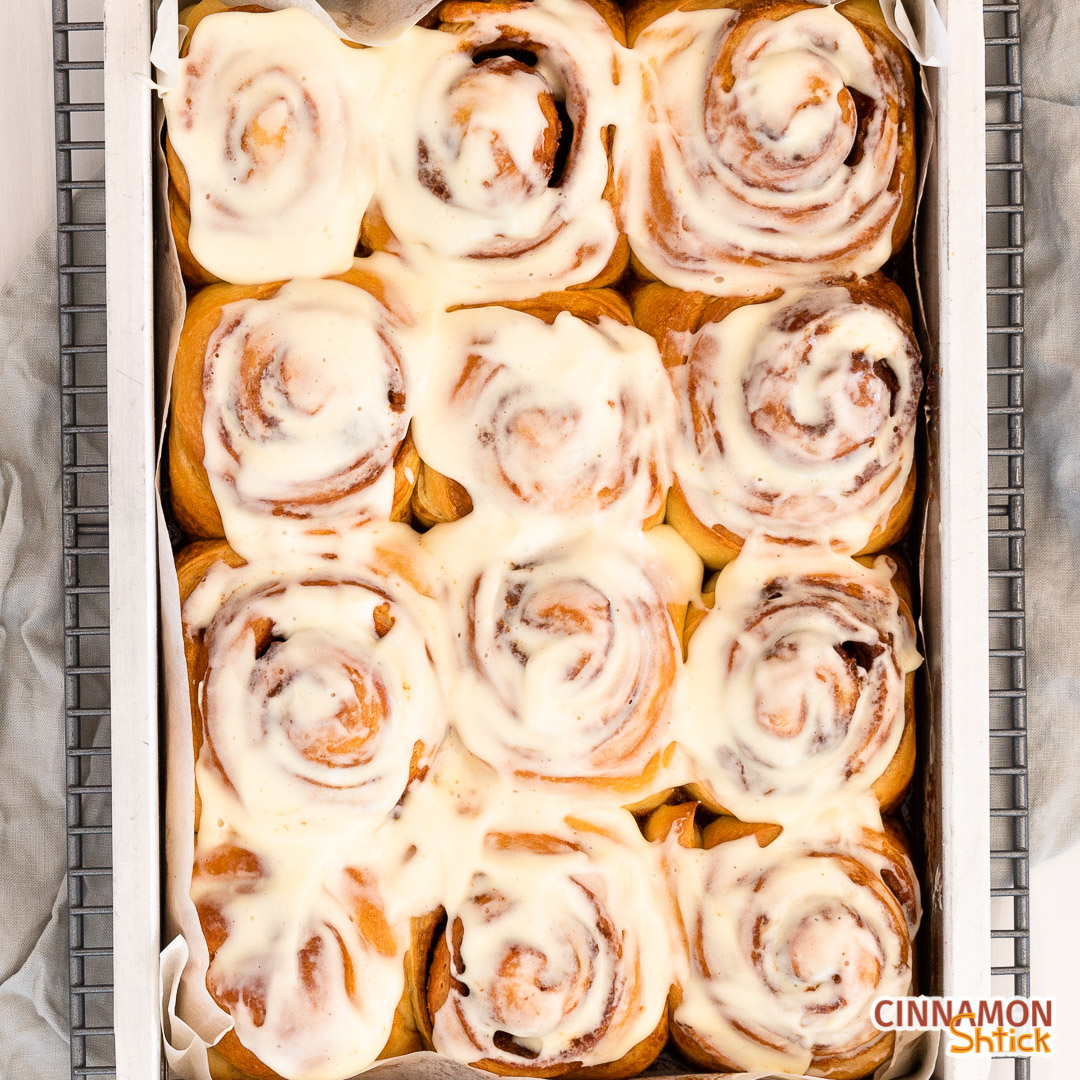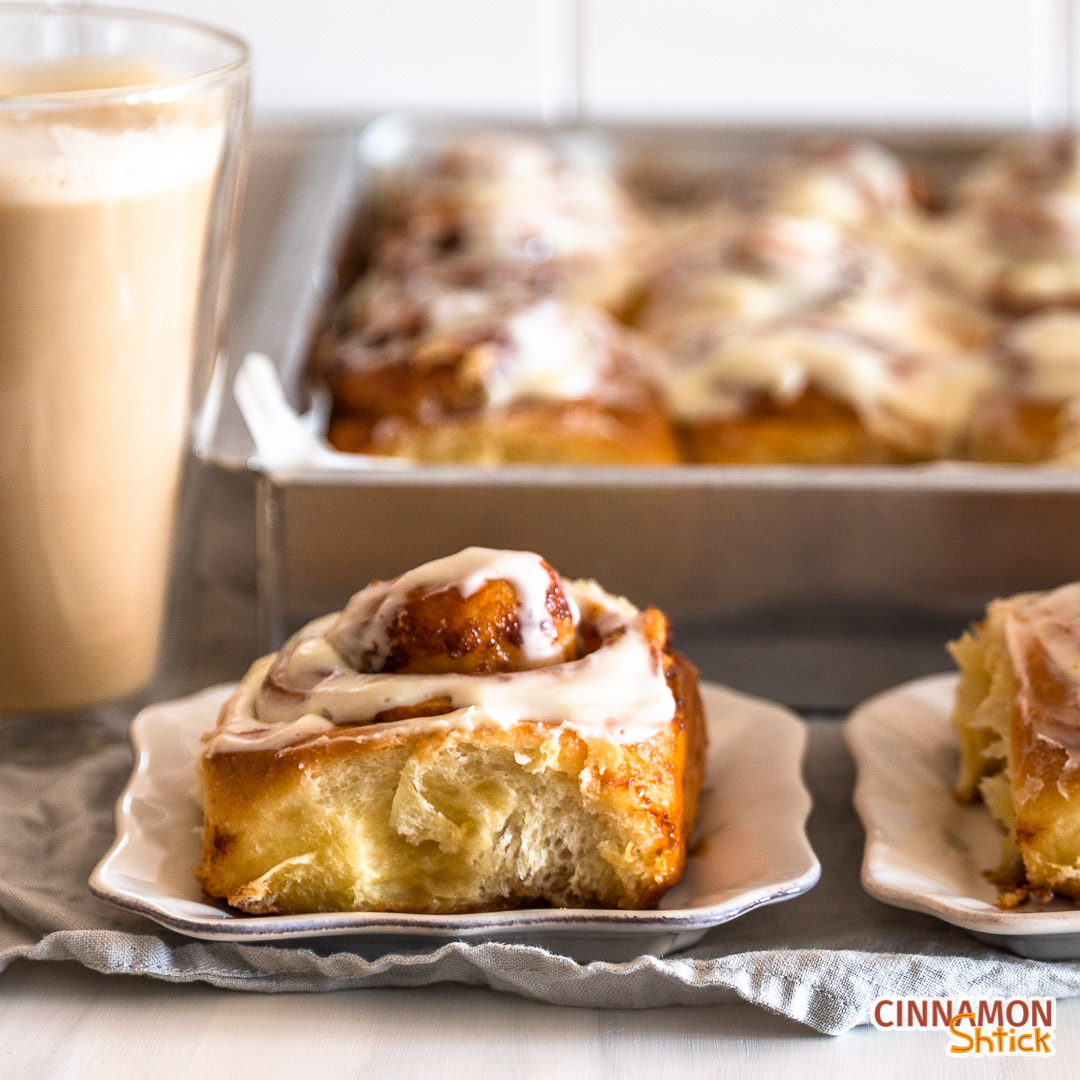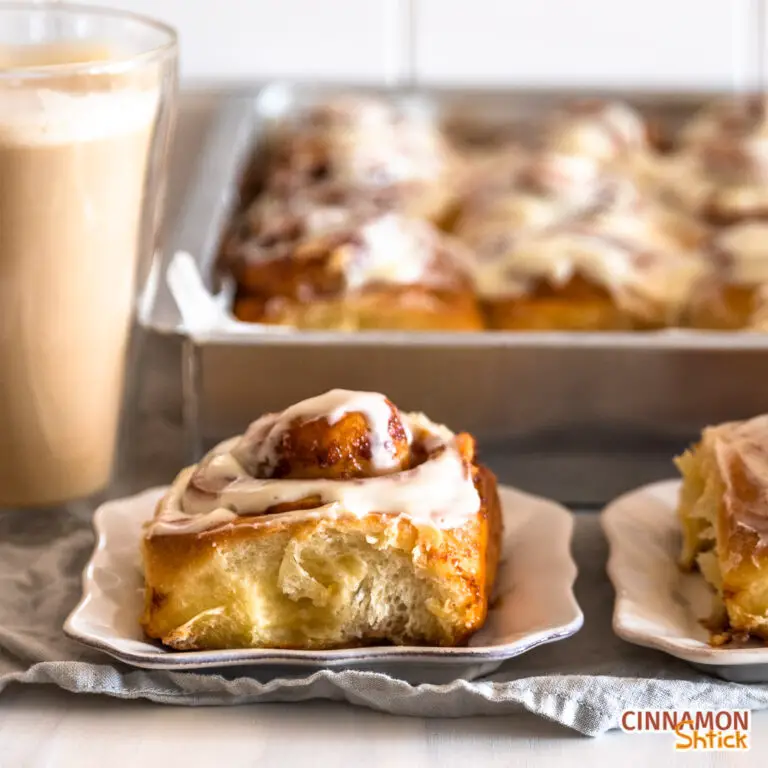This post may contain affiliate links. As an Amazon Associate, I earn from qualifying purchases. For more information, please visit my Privacy Policy.
I have yet to meet someone who does not enjoy a cinnamon roll. #truestory. You know how people need oxygen to breathe? Well, I need cinnamon rolls to live. Now, you might be asking, don’t you have a cinnamon roll recipe on Cinnamon Shtick already? Well, yes, of course I do. But there is always — and I mean always — room for more cinnamon roll recipes. The first Cinnamon Rolls recipe I posted is absolutely delish. I mean, DELISH!!! This recipe for Brioche Cinnamon Rolls, while different, is just as, if not even more, DELISH!

What are Brioche Cinnamon Rolls?
Brioche is basically French bread of the gods, loaded with eggs and butter. It’s kind of like taking Challah and adding butter to it. Just when we thought Challah couldn’t get any better! This dough is so super soft, fluffy and delish.
How to Make the Dough for Brioche Cinnamon Rolls
These Brioche Cinnamon Rolls are actually easy to make. Best of all, they are best made the day before and rested in the refrigerator overnight. Why is that so great? Because you don’t have to get up at the crack of down to have yourself warm cinnamon rolls for breakfast!
Let’s Talk Yeast
You can use either active dry yeast or instant yeast in this recipe. (Actually, in any yeast recipe you can use either.)
If using active dry, you need to add it to the warm milk to dissolve the coating around each granule. Don’t let the milk get too hot though or you’ll kill the yeast. (Murderer!) It is best to add a pinch of sugar to the yeast/milk mixture to feed the yeast a bit. It should take no more than 5 minutes or so to get the yeast bubbly, foamy and therefore activated. If it is not foamy after 10 minutes, the milk may have been too hot, killing the yeast, or the yeast could be dead. Active dry yeast stored in the refrigerator should last for at least a few months in an airtight container.
If using instant yeast, your milk should still be warm, but you can just toss in the milk and yeast with the rest of the ingredients because there is no coating on instant yeast like there is on active dry yeast. The only thing to keep in mind is that you should decrease the amount of instant yeast to 5 grams. Why? Approximately 25% of active dry yeast is dead, but 100% of instant yeast is alive and well. You therefore do not need to use quite as much yeast when using instant yeast. Instant yeast also lasts for at least a few months in an airtight container in the refrigerator.
The Special Ingredient in these Brioche Cinnamon Rolls
This brioche dough is already soft and pillowy. I add dried milk powder to the recipe to take it even more over the top of soft and fluffy. The milk powder I used is dry whole milk from King Arthur Baking. You can also use King Arthur’s baker’s special dry milk. There are other dried milk powders available on Amazon, such as this one and this one.
Mix and Knead the Dough
Use your mixer for this. It is a life saver! With the dough hook, knead all the ingredients (except for the salt and butter) together. Once you get the dough kneaded pretty well, you will slowly add in the salt. (Nerd alert: We do not add the salt in immediately because it can slow down or even kill the yeast upon initial contact. Adding the salt once the dough is mostly mixed eliminates that risk.)
Knead the dough until it passes the windowpane test. Say what!?!? Take a small piece of dough (like 1 teaspoon or so worth) and stretch it with your fingers. If it stretches without ripping to the point where the dough is translucent, you have passed the windowpane test. Congrats! If it rips too easily, knead it for another minute or two until it passes the test.
Knead in the Butter
Butter is what makes brioche the spectacular dough that it is. Adding the butter is easy, but it takes time and patience. This is another reason why using the mixer makes this so simple. The key to this step is to add the butter in small pieces, about 1 tablespoon at a time. Allow each tablespoon or so to fully knead in before adding the next tablespoon. It will take ten minutes or so to get all the butter incorporated. You will be grateful you spent this time doing so!
How to Shape Brioche Cinnamon Rolls
After the dough is left to rise for a bit, you will roll it out on a lightly floured surface, at least 19 inches long by 14 inches wide. Spread some room temperature butter on it, and sprinkle the cinnamon sugar mixture all over the butter. With the 14 inch side facing you, roll it up, somewhat tightly. Press the seams together at the end. Cut off about half an inch on each end. Then, with a serrated knife (or unflavored dental floss), cut 12 rolls, each 1½ wide. Arrange them in a prepared 9″ x 13″ pan. None of them should touch, and it may seem like there’s too much room. Don’t sweat it! The dough will rise overnight in the refrigerator and when they bake the next morning.


How Do I Know When the Brioche Cinnamon Rolls are Done?
The Brioche Cinnamon Rolls are done when they are golden brown on top and the internal temperature is about 205-210°F. To take the temperature of the rolls, I highly recommend a Thermapen thermometer from ThermoWorks. I literally use it to take the temperature of anything I make, from ice cream to breads to tempering chocolate.

Don’t Forget the Icing!
I believe that the cream cheese icing is what separates a cinnamon roll from all other divine cinnamon pastry products. The contrast of the tang to the sweet roll is a satisfaction unworthy of just words. That, my friends, is why you cannot forget the icing! While the Brioche Cinnamon Rolls are in the oven, prepare the icing. It is best to shmear (that’s Yiddish for “spread”) it on just after the rolls come out of the oven. Dollop a spoonful on each roll, then use a spatula or a knife to spread all over.


Frequently Asked Questions
What’s the best way to roll out the brioche cinnamon roll dough?
Place the dough onto a lightly floured work surface. Shape the dough into a rectangle with your hands. Lightly flour the top of the dough and a rolling pin. Roll the dough from the center towards the top, then from the center towards the bottom, just a few times to start shaping the dough. Put the rolling pin down and lift the dough up. Doing so helps ensure the dough is not sticking to the work surface and allows you to stretch the dough from the ends to get squared off edges. Keep repeating and rotating the dough as necessary to roll it the correct dimensions.
Is there a substitute for dried milk powder?
The dried milk powder adds to the consistency of this dough. If you don’t have it, you can skip it. You can also use malted milk powder in its place.

Brioche Cinnamon Rolls
Ingredients
Dough:
- 7 grams active dry yeast or instant yeast* (1 envelope or 2¼ teaspoons)
- 245 grams milk** (1 cup)
- 75 grams granulated sugar, divided (⅓ cup plus 2 teaspoons)
- 1 large egg, at room temperature
- 1 large egg yolk, at room temperature
- 2 teaspoons vanilla extract
- 480 grams all purpose flour (4 cups)
- 30 grams dried milk powder (¼ cup)
- 5 grams salt (1 teaspoon)
- 113 grams unsalted butter, at cool room temperature (8 Tablespoons or ½ cup)
Filling:
- 220 grams light brown sugar (1 cup)
- 1 Tablespoon ground cinnamon
- ¼ teaspoon kosher salt
- 57 grams unsalted butter, room temperature (4 Tablespoons)
Icing:
- 113 grams cream cheese, room temperature (4 ounces)
- 55 grams confectioner's sugar (½ cup)
- 1 teaspoon vanilla
- Pinch of kosher salt
- 30-45 grams milk (2 to 3 Tablespoons)
Instructions
- Dough. [If using instant yeast, skip to Step 3 and add the yeast and the milk with the rest of the ingredients.] In microwave at 20 second intervals, stirring after each interval, warm milk to body temperature, generally between 105°F and 110°F. Alternatively, you can heat the milk in a saucepan on a low flame, stirring constantly. Either way, do not let the milk get above 115°F. (If you do, just let it sit out at room temperature for a couple of minutes constantly checking it until it cools to body temperature.)
- Place warmed milk into bowl of electric mixer. Sprinkle yeast and approximately 1 tsp. of the sugar over the milk. Using a fork, stir the mixture to distribute the sugar and hydrate the yeast granules. Allow to sit for approximately 3-5 minutes until the mixture gets foamy.
- Add the room temperature egg, the room temperature egg yolk, and the vanilla to the mixture. Using the dough hook, turn the mixer on at a low speed and add the rest of the sugar. With the mixer running at the lowest speed, add the flour and dried milk powder. As the flour starts to get absorbed by the liquid mixture, raise the mixer to a medium speed. You may need to turn the mixer off once or twice to wipe down the sides of the bowl with a rubber spatula. Allow to knead for approximately 3 minutes. The dough should clean the sides of the bowl and be tacky, even a bit sticky. If it is too wet (sticking to the sides and bottom of the bowl), add some flour, no more than 1 tbsp. at a time. If the mixture is too dry, add a little milk, 1 teaspoon at a time.
- Lower the mixer speed to low (1 or 2 on the KitchenAid) and slowly add the salt, allowing it to knead into the dough, an additional 3 minutes. Stop the mixer and take a small piece (approximately 1 teaspoon) of dough and stretch it between your fingers. It should form a “window pane”, meaning it should get thin enough that it is translucent without it ripping. If it is not at that point yet, continue kneading in the machine at 1 minute intervals. (It may just need an additional minute or two to reach the window pane stage. If it still isn’t there yet, check to see if the dough is too dry. If it is, add ½ teaspoon milk and knead another minute.)
- With the mixer running at medium speed, add the butter. It is best to add it one piece at a time, waiting until it is fully integrated into the dough before adding the next piece. You may need to turn off the mixer from time to time to push the slab of butter back into the range of the dough and the hook. This process will take approximately 5-10 minutes. Once all the butter is incorporated, the dough will look shiny and be slightly sticky. (If, after approximately ten minutes, the butter is still not fully incorporated, do not panic. Just move to the next step – having some unincorporated butter is not problematic in this recipe. That said, the key to incorporating the butter is nothing more than patience.)
- Lightly grease a bowl with a little butter or nonstick cooking spray. Form dough into a ball and place it in the bowl. Turn the dough over to coat it in the butter or nonstick cooking spray and cover tightly with plastic wrap. Let the dough sit in a warm area on the counter until doubled in size, approximately one hour.
- Prepare a 9 inch by 13 inch pan by either lining it with parchment paper, spraying it with non-stick spray, or buttering it.
- Filling. In a bowl, stir the brown sugar with the cinnamon and salt. Set aside.
- Punch down the dough, giving it two or three kneads. Roll it out to a rectangle, at least 19 inches long and about 14 inches wide. Have the dough facing you so that the width is 19 inches and the 14 inches runs vertically.
- Spread the room temperature butter all over the dough, leaving ¼ inch border across the top unbuttered.
- Sprinkle the filling all over the butter and spread it evenly.
- Roll the dough up, away from you, in a tight roll. If the dough is sticking, flour a metal spatula to slide under the dough as you roll, or, if you are rolling on parchment paper, use the parchment to lift the dough up and roll it onto itself. Close the seam at the top.
- Using a ruler, cut 12 rolls, each 1½ inches wide. Place them in the prepared pan, 4 across the 13 inch side, and 3 along the 9½ inch side. There should be plenty of space between the rolls. Cover the pan with plastic wrap completely so no air can get in. Refrigerate overnight.
- The next morning, remove the pan from the refrigerator. Rest them on the counter for approximately 1½ hours. They should almost double in size.
- About an hour into the last rise, preheat the oven to 350°F.
- Bake the rolls for 35-40 minutes. The tops should be golden brown, and they should not jiggle when you move the pan. If you are using a thermometer, the inside temperature should be about 210° F.
- Icing. After the rolls have been in the oven for 30 minutes, whisk together all the ingredients for the icing, starting with just 2 tbsp. of the milk. If the icing is too thick, add a little more milk until you reach a smooth, spreadable consistency. When the rolls come out of the oven, dollop a spoonful of the icing on each roll. Spread the icing all over. Allow to cool at least 20 minutes before serving.


4 Comments
Looks so fluffy!
Never thought I can combine these together! Looking forward to making these brioche cinnamon rolls
These turned out amazing!
Perfect Christmas morning treat! These fluffy buns were easy to make and tasted fantastic! Full of cinnamon but not overly sweet like some other recipes. The texture was light and airy, and there is no better smell in a kitchen than cooking these buns!